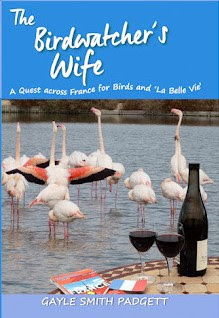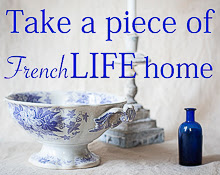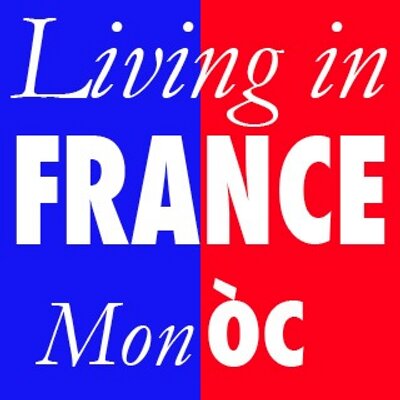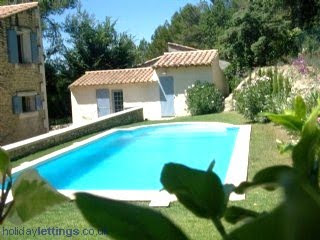Saturday, July 31, 2010
The Cocktail Drinkers' Guide to Gardening: July
(*Note to houseguests: Yes, datura is poisonous and yes, James makes a lethal margarita. But here James means blow you away in the 'you'll be delighted and amazed' sense...not in the 'what, you're leaving so soon?' sense or the 'oh dear, I've killed the houseguests again!' sense.*) Anyway, here he is...
It's fitting that the Romans brought so much to Provence that even the month of July was named, by Mark Anthony, in honor of Julius Caesar. I also note from my intense research (lasting all of eight minutes) that St. Julian is the Patron Saint of Travelers and Hospitality—something that we who live in Provence know a lot about. Well, we certainly know about the 'hospitality' side of things. If, like me, you have house guests coming and going, here are two items that I feel they should share with you during this month. They’ll love both.
As you have to admire the datura plant with a margarita in hand I suggest that you pop down to you local pépinière (nursery). The shrub (evergreen to semi-evergreen) I have in mind is really amazing, commonly named "Angels Trumpet" (not that I'm in a hurry to hear one of those). It’s also known as datura and for those who are fluent in Latin (and who isn't these days?), it’s the Brugmansia solanaceae. The specific variety I recommend, because it's hardy (meaning it’s tough and will come back next year like certain house guests), is suaveolens. It’s white, with hanging trumpet flowers (15-20cms/6-8 inches) that are very heavily scented and open only as the evening commences. In fact, usually at the cocktail hour! By morning they’re wilting but a new crop is always there for the first drink of the evening. Bees go crazy attempting to get into them as the flowers quickly open, so quickly that you can almost watch it happening if you have a mind to give them your attention for half an hour or so.
As we all know, beauty generally comes with some cost and in this case, it’s that the datura is rather poisonous, particularly the seeds. In fact, the whole thing could kill you if you ate it but then again it wouldn’t be on my list of favourite things to eat.
It’s not advised to plant datura if you have small children around or perhaps it’s ideal if you don’t want any around. I’ll leave that up to you to decide.
Great--so far so good. You’ve found the datura and now you have to plant it up. It wants full sun and protection from the wind, as would you if, like this shrub, you were native to South America. The terrace is therefore a great place to plant it (plus, this allows you to view it from your lounger, which makes it almost ideal).
Datura can get quite big, up to two meters or more, so give it some space. I don’t recommend planting this variety in a pot. Once it’s up and running (not a gardening term I’ve ever heard but, hey, you get what I mean), water it well but only once a week. If you see it flagging when the weather gets super hot, water it some more.
Speaking of flagging and all that shopping and ‘planting up’ your fantastic new tropical shrub, it’s getting close to cocktail hour. On your way home from the garden center, you should swing by the store and pick up the following: one bottle of Tequila (Silver or Gold), one bottle of Cointreau (or Triple Sec) and at least a dozen fresh limes to make juice. Use Pulco Citron Vert if you can’t find fresh limes.
Yep, you’ve now got the ingredients for the Classic Margarita. Here’s the low down: three, two, one. (Math was not my favorite subject at school but those proportions you just can’t forget!) Here’s the recipe.
Three measures of tequila (ever noticed how close that word sounds to ‘to kill yer’--I’ll let you mull that one over); two measures of Cointreau ; and 1 measure of fresh lime juice (if using Pulco Citron Vert, make the proportion a half measure as it’s a concentrate). You have to have loads of ice: that way it lasts even longer and the melting ice will take some of the power out of what otherwise, even standing up, can become a major event. Crushed is best so either you have a fancy machine or you put the ice in a bag and smash it against something hard (preferably not your partner).
Now you’re all set. Wet the rim of a cocktail glass and lightly dip it into a plate of salt--the salt provides a nice sour/sweet contrast and has the effect of making you drink even more! Make up a pitcher-full; that way you won’t have to stagger back to the kitchen to make more.
Cocktail gardening is not quite as ridiculous as it may sound, particularly in July when the opportunities for actually planting are few. The 'cocktail hour' is also the perfect watering time for the pots on your terrace; at the end of the day, in the cool of the evening—and just like us--they too enjoy a good drink. I recommend that you water them very well every two to three days and not lightly every day…you will soon notice a difference. Enjoy July! It is, after-all, high summer and time to relax.
Pip Pip!
Saturday, July 24, 2010
Provence All Over the Web...

I've seen lots of great Provence and France articles online during the last month or so. And because I live to please you, dear reader, I've collected some of the best. Here you go...enjoy!
In the New York Times, Eric Asimov rated 20 rosé wines from Provence. Read all about it here.
The Times also featured a great piece about the Luburon.
Have any of you tasted Andrea Calek's wines? I haven't but would love to.
Is Cassis the new St. Tropez? See what the Telegraph says here.
Peter Mayle tells what he loves about Provence, in the Telegraph, here.
Jancis Robinson writes about wines from the Languedoc-Roussillon, which is technically of course not Provence but close enough for me.
Not for the casual biker: cycling the Gorge du Verdon.
Here's a feel-good article about people Collecting plastic debris from the sea.
Reuters reported that two French lawmakers have presented a bill to ban bullfighting.
The Wall Street Journal featured a short, sweet remembrance of the author's first attempts to speak to the Frenchman who later became her husband. Read it here.
Here's a nicely done diary of a birders' trip to Provence...
Finally! A tour operator that understands that not every traveler wants to be on the bus by 8 a.m.! Go here.
Starbucks is adapting to local tastes in France.
The Guardian ran a helpful guide to Summer in French cities including Arles, Avignon, Marseille and Nice.
In a book review/essay, the Financial Times calls the Gard "the secret South of France." Read it here.
OK, this one isn't about Provence but it's cool anyway: Glamorous camping (glamping!) in the Loire Valley.
Also from the Guardian, the ten best flea markets in France.
Exploring the perched villages of the Riviera.
Interested in real estate? The New York Times has a lovely house for sale between Arles and Avignon (1.2 million euro) and discusses the property market in the Bouches du Rhone today.
The Olive Oil Times (who knew?) ran a nice feature about Marseille and the history of olive oil.
If you're a rock climber or would like to be, here are some of the best spots in the region.
Market day in Aix...
Provencale Pizza from the Huffington Post...
What do you think happened when Carol Drinkwater tried to turn her French olive grove organic? Read all about it here.
Don't live in Provence? Pretend you do...by throwing this Provencale-style dinner party, complete with the right drinks, music, etc.
Here's an update on the Provencale winery that hired all those famous architects.
How about some tips for making your trip to France more affordable? Go here.
Want to see Jerry Hall in a swimsuit? Sure you do.
Finally, Brad and Angela are reportedly looking to buy a vineyard now that the lease on their Provencal chateau is almost up. Meanwhile I swear I saw them at Aldi the other day, buying cheap tequila and off-brand cat food...
Photo by Tony Cenicola/The New York Times
Wednesday, July 21, 2010
Apricots Are Us
Katie Dahlstrom is a journalist with BBC World Service News. Originally from California, she moved to London after university, and fell in love with both England and Europe. After years of rainy summers, she and her husband Ben--a musician--sought out the sun and found it in southern France. They now divide their time between London and the tiny village of Le Barroux in the Vaucluse. Katie's crazy about the seasonal produce in Provence and these days, she's all about apricots. I asked her to share the love. She writes:
Summer is finally in full swing. Although it arrived late, no one's complaining about the heat just yet. The very cold winter and spring made us think we’d never see another summer. But the cherries ripened, albeit slowly this year, and now we’re finally enjoying our beautiful plump apricots here in the Vaucluse.
The most striking thing about the apricots is that they have gained their own equivalent of Appellation d'Origine Controlee--the Label Rouge, a sign of quality food production throughout France. Along with the cherries from the Mont Ventoux, these fruit set the standard for taste and quality anywhere on the continent. Originally from China, the humble apricot came to Provence from Armenia along the silk route. But it’s here in the Haut Vaucluse and the Drome that the tree and its fabulous fruit has truly flourished.
There are loads of varieties of apricots growing around the Vaucluse and Languedoc. But the two big guns are the Bergarouge and Orange de Provence (Orange Rubis). They thrive at an altitude of around 400 m above sea level, and particularly in the valleys around the town of Nyons. So if you head out towards Nyons from Vaison la Romaine you’re right in the heart of Apricot central. Local producers set up their stalls on the side of the road much like they do with the cherries early in the summer. So if you’re travelling around the region, do stop and grab yourself a treat.
In normal years we’d see the Early Blush variety in the supermarkets from the beginning of June. This year with such long lasting cold weather in spring, everything’s about 2 weeks late. So I was seeing the first apricots in the markets just around the 15th of June. That will of course mean the season for our lovely late fruiting Tardive de Vaucluse and Fantasme should come in late July/early August.
The Bergarouge and Orange de Provence are widely seen to be the best eating apricots, as well as for making jam. You can tell the Bergarouge from it’s colour: a fat orange skin, with a pinky red hue, bursting at the seams with juicy goodness. The Orange de Provence is slighly smaller, a medium sized apricot, with a light pink blush. And everyone who has the time gets out the pots and makes some lovely home made apricot jam from her mother’s recipe. Here in the upper Vaucluse, the jam you find in the markets is chunky--fat, sweet pieces of fruit in a thick unctuous syrup. Not too sweet, but absolutely delicious. Some people even leave in the apricot seeds which gives the jam a nice little crunch. And if you have the opportunity to go to one of the local markets around Carpentras, you’ll find a special apricot and lavender jam. Sounds slightly weird, I know. But believe me, it’s gorgeous. Put a little bit on the side with a perfectly cooked magret de canard, some mesclun salad leaves, and you’ve got a gourmet dinner in minutes.
The season is short, but the fruit is fabulous. So enjoy it while you can.
Katie can be reached at: katie.dahlstrom@blueyonder.co.uk
Katie can be reached at: katie.dahlstrom@blueyonder.co.uk
Wednesday, July 14, 2010
Screamin' Deals on Two St. Remy Rentals
GREAT DEAL #1
In St. Remy, Lorraine Boulogne has a few holes to fill in her summer rental schedule and she's offering the readers of Provence Post a great discount. Her house (two pictures above) has four double bedrooms, two large living rooms, a large kitchen/dining area, a long covered stone terrace for barbecues and outdoor dining, a large pool, a secure gated driveway and garage, and room to park five cars. There's also a charming one-bedroom, one-bath guest cottage that's included in the price of 1400€ euro per week. To learn more click here and then email: rod.boulogne@lastwordmedia.com.
GREAT DEAL #2
Due to a last minute cancellation, the rental property known as The Garden House in St.Remy (two pictures above) is available for 1000€ for two people for one week, July 24th - July 31st. That's a 500€ discount. For all the details, click here or email james@jamesclay.fr
Labels:
PROVENCE TRAVEL,
REAL ESTATE,
RENTAL PROPERTIES,
ST. REMY
Friday, July 9, 2010
Irving Penn's Les Petits Metiers
Legendary American photographer Irving Penn who passed away in 2009 aged 92, shot a striking series of portraits of workers in mid 20th-century France, London and New York. They're currently on view in Paris at the Fondation Henri Cartier-Bresson, through July 25th. The show is called Les Petits Métiers (Small Trades). You can see more images at the Fondation's website or on Le Monde's blog.
Labels:
ART AND PHOTOGRAPHY,
PARIS
Tuesday, July 6, 2010
New Art Festival Launches Thursday
_Michael_de_Feo+(1).jpg)
When I heard that AP’art, a new regional art festival, was coming our way this week, I asked my artsy friend Angela Billows to give us all the details. Here’s her report.
This year sees the launch of Ap’art, an international contemporary art festival set amongst the beauty of the Alpilles Mountains. It runs from July 8 to 13, to coincide with the summer festivals in Aix-en-Provence, Arles, Avignon and Marseille.
Based in St Rémy and extending within a 10 mile radius (from Orgon to Tarascon, including Noves, Eygalieres, Les Baux, Mausanne and St-Etienne-du Grès), the festival will take place in 30 or so venues with roughly 60 artists participating over a six-day period.
But don’t expect galleries with white walls; the Festival is being staged in sites as diverse as the art itself: town halls, museums, chapels, vineyards, hotels, quarries, parks and gardens--as well as the artists’ own studios.
One of the aims of the Festival is to make contemporary art accessible to everyone and many of the artists will be on hand to discuss their work. Besides exhibits and installations, the schedule includes lectures, debates, film screenings, picnics and dinners.
Each year, the Festival will select a well-known artist to show his or her work in a medium different from the one for which he is known. This year Jessica Lange, actor and two-time Oscar winner, will be exhibiting her black and white photographs at Hotel L’Ateliers de L’Image in St Rémy.
Auctions benefiting the non-profit group A3-art, organizers of the festival, will take place on Place Jules Pellisier in St. Remy on Saturday July 10 at 11:45 a.m. and Sunday 11th July at 11:30 a.m. Among the items to be auctioned are original artworks created specifically for the festival
Wherever you go in this part of Provence during the next six days, you’ll see something happening. So get out there and see, feel and smell the art of the Alpilles!
Here are a few of the exhibits likely to be festival highlights:
In Les Baux, Jean Verame and Marke Newton will be projecting their art onto the rocks.
In the quarry of Mas de la Pyramide in St Rémy, you can experience Flower Fractal, a garden of virtual flowers by Miguel Chevalier.
In Tarascon at the foothills of the Alpilles, you can visit the beautiful Chapel St Gabriel, which dates to the 12th century, and daydream for a moment in a bamboo bubble cocoon created by Myriam Goubey.
In the town of Tarascon itself, you can visit the exhibition of Pierre-Marie Brisson in Les Cordeliers, a 14th-century monastery. Whilst there, be sure to visit Souleiado, the home and museum of the Provencal fabric maker, where you’ll see the work of Michael de Feo. Further down the road, Wolfgang Votz will be showing his landscape photos at La Chapelle de Persévérance.
As you’re out and about, look for Ultra Violet (of Andy Warhol fame), who will be filming artists and festival-goers around St Rémy.
AP’art kicks off with two opening ceremonies, one in St. Remy and one in Les Baux. The first is 7:30 p.m. on July 8 in front of the Mairie (Place Jules-Pellissier) in St. Remy. Mayor Herve Cherubini, tourism and local officials and artists will be in attendance.
In Les Baux, the inauguration ceremony will be Friday July 9 at noon, at the cistern.
For more information: www.festival-apart.org
Angela Billows, a costume designer for film and tv, and her husband, the painter Jake Paltenghi, live in Tarascon. (Angela blogs about life in Provence here. Jake's website is here.) As part of the Ap’art festival, Jake will be showing paintings and sculptures inspired by walks in the Alpilles. His studio (opposite Souleiado, at 38 rue Charles Demery) will be open daily 3-6 p.m. To reach Jake or Angela: 04-90-52-28-41.
Saturday, July 3, 2010
Love Photography? Get Thee to Arles!
The Rencontres d'Arles is an international photography expo that takes over the city of Arles each summer with seminars, workshops, gallery shows, open-air projections and more. It's Europe's biggest photo festival and, some say, the most important event of its type in the world. The 41st annual festival opens officially today and runs through Sept 19th.
Over the years Arles has played host to many of the most significant figures in photography including Ansel Adams, Brassai, André Kertesz and Nan Goldin.
This year, the Rencontres features six themed "trails": through Argentina, rock music, film photography, "changeovers," prison life and the sixth with the friends of the LUMA foundation. Each trail begins with a guest of honor or an emblematic show. There are also scores of "off trail" exhibitions.
Mick Jagger is one of the main attractions this year: more than 70 portraits of him are on display, taken by everyone from Cecil Beaton to Annie Leibovitz. The images trace Jagger's life from the 1960s until today and festival organizers are hoping that he will put in a personal appearance.
Other highlights will include a selection of works by Vienna-born Ernst Haas, made using Kodachrome slide film. One of the photographers of the legendary agency Magnum, Haas is known for his innovations in color photography.
Another important show is a first-ever French retrospective for 90-year-old Argentine artist Leon Ferrari.
Evening screenings begin Monday night, July 5th.
"The Night of the Year" of a 14-screen photo trail around Arles that runs from 8 p.m. until dawn on Friday July 9th.
The Rencontres has seen visitor numbers rise by an average of 20 percent a year since 2001, with a record 72,000 people attending last year.
Over the years Arles has played host to many of the most significant figures in photography including Ansel Adams, Brassai, André Kertesz and Nan Goldin.
This year, the Rencontres features six themed "trails": through Argentina, rock music, film photography, "changeovers," prison life and the sixth with the friends of the LUMA foundation. Each trail begins with a guest of honor or an emblematic show. There are also scores of "off trail" exhibitions.
Mick Jagger is one of the main attractions this year: more than 70 portraits of him are on display, taken by everyone from Cecil Beaton to Annie Leibovitz. The images trace Jagger's life from the 1960s until today and festival organizers are hoping that he will put in a personal appearance.
Other highlights will include a selection of works by Vienna-born Ernst Haas, made using Kodachrome slide film. One of the photographers of the legendary agency Magnum, Haas is known for his innovations in color photography.
Another important show is a first-ever French retrospective for 90-year-old Argentine artist Leon Ferrari.
Evening screenings begin Monday night, July 5th.
"The Night of the Year" of a 14-screen photo trail around Arles that runs from 8 p.m. until dawn on Friday July 9th.
The Rencontres has seen visitor numbers rise by an average of 20 percent a year since 2001, with a record 72,000 people attending last year.
You can see a quick video introduction to the festival here.
For all the info: www.rencontres-arles.com, 04 90 96 76 06 or info@rencontres-arles.com
For all the info: www.rencontres-arles.com, 04 90 96 76 06 or info@rencontres-arles.com
Subscribe to:
Posts (Atom)




























































.jpg)

.jpg)













